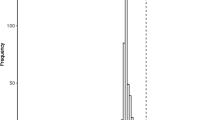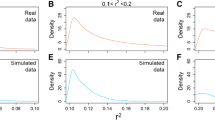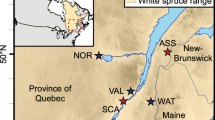Abstract
Genomic selection (GS) can be a powerful technology in conifer breeding because conifers have long generation intervals, protracted evaluation times, and high costs of breeding inputs. To elucidate the potential of GS for conifer breeding, we simulated 60-year breeding programs in Cryptomeria japonica with and without GS. In conifers, the rapid decay of linkage disequilibrium (LD) can constitute a severe barrier to application of GS. For overcoming that barrier, we proposed an idea to leverage a seed orchard system, which has been used commonly in conifers, because some degree of LD exists in progenies derived from the limited number of elite trees in a seed orchard. The base population used for simulations consisted of progenies from 25 elite trees. Results show that GS breeding (GSB) done without model updating outperformed phenotypic selection breeding (PSB) during the first 30 years, but the genetic gain achieved over the 60 years was smaller in GSB than in PSB. However, GSB with model updating outperformed PSB over the 60 years. The genetic gain achieved over the 60 years of GSB with model updating was nearly twice that of PSB. Advantages of GSB over PSB prevailed, even for a low heritability polygenic trait. The number of markers necessary for efficient GS was a realistic level (e.g., one in every 1 cM), although higher marker density engendered higher accuracy of selection. These results suggest that GS can be useful in C. japonica breeding. Updating of the prediction model was, however, indispensable for attaining the large genetic gain.







Similar content being viewed by others
References
Breiman L (2001) Random forests. Mach Learn 45:5–32
Drucker H, Burges CJC, Kaufman L, Smola A, Vapnik V (1997) Support vector regression machine. Adv Neural Info Proc Syst 9:155–161
Goddard ME, Hayes BJ (2007) Genomic selection. J Anim Breed Genet 124:323–330
Grattapaglia D, Resende MDV (2010) Genomic selection in forest tree breeding. Tree Genet Gen
Gupta PK, Rustgi S, Kulwal PL (2005) Linkage disequilibrium and association studies in higher plants: present status and future prospects. Plant Mol Biol 57:461–485
Haldane JBS (1919) The combination of linkage values and the calculation of distances between the loci of linked factors. J Genet 8:299–309
Hashizume H (1959) The effect of gibberellin upon flower formation in Cryptomeria japonica. J Jpn For Soc 41:375–381
Hayes BJ, Bowman PJ, Chamberlain AJ, Goddard ME (2009) Invited review: Genomic selection in dairy cattle: progress and challenges. J Dairy Sci 92:433–443
Heffner EL, Sorrells ME, Jannink JL (2009) Genomic selection for crop improvement. Crop Sci 49:1–12
Hoerl A, Kennard R (1970) Ridge regression: biased estimation for non-orthogonal problems. Technometrics 12:55–67
Honma R, Yoshii E, Taira H (2006) Shortening examination cycles of male-sterile Cryptomeria japonica trees. J Jpn For Soc 88:30–32
Husband BC, Schemske DW (1996) Evolution of the magnitude and timing of inbreeding depression in plants. Evolution 50:54–70
Jannink JL, Aaron JL, Iwata H (2010) Genomic selection in plant breeding: from theory to practice. Brief Funct Genomics 9:166–177
Kuramoto N, Kondo T, Fujisawa Y, Nakata R, Hayashi E, Goto Y (2000) Detection of quantitative trait loci for wood strength in Cryptomeria japonica. Can J For Res 30:1525–1533
Lande R, Thompson R (1990) Efficiency of marker-assisted selection in the improvement of quantitative traits. Genetics 124:743–756
Meuwissen THE, Hayes BJ, Goddard ME (2001) Prediction of total genetic value using genome-wide dense marker maps. Genetics 157:1819–1829
Moriguchi Y, Tani N, Itoo S, Kanehira F, Tanaka K, Yomogida H, Taira H, Tsumura Y (2005) Gene flow and mating system in five Cryptometia japonica D. Don seed orchards as revealed by analysis of microsatellite markers. Tree Genet Gen 1:174–183
Neale DB, Savolainen O (2004) Association genetics of complex traits in conifers. Trends Plant Sci 9:325–330
Ohba K (1993) Clonal forestry with sugi (Cryptomeria japonica). In: Ahuja MR, Libby WJ (eds) Clonal forestry II, Conservation and application. Springer, Berlin, pp 66–90
R Development Core Team (2008) R: A language and environment for statistical computing. R Foundation for Statistical Computing, Vienna, Austria. ISBN 3-900051-07-0, URL http://www.R-project.org
Sved JA (1971) Linkage disequilibrium and homozygosity of chromosome segments in finite population. Theor Popul Biol 2:141–155
Taira H, Saito M, Furuta Y (1999) Inheritance of the trait of male sterility in Cryptomeria japonica. J For Res 4:271–273
Tani N, Takahashi T, Iwata H, Mukai Y, Ujino-Ihara T, Matsumoto A, Yoshimura K, Yoshimaru H, Murai M, Nagasaka K, Tsumura Y (2003) A consensus linkage map for sugi (Cryptomeria japonica) from two pedigrees, based on microsatellites and expressed sequence tags. Genetics 165:1551–1568
Tsumura Y, Kado T, Takahashi T, Tani N, Ujino-Ihara T, Iwata H (2007) Genome scan to detect genetic structure and adaptive genes of natural population of Cryptomeria japonica. Genetics 176:2393–2403
Ujino-Ihara T, Kanamori H, Yamane H, Taguchi Y, Namiki N, Mukai Y, Yoshimura K, Tsumura Y (2005) Comparative analysis of expressed sequence tags of conifers and angiosperms reveals sequences specifically conserved in conifers. Plant Mol Biol 59:895–907
Vapnik V (1995) The nature of statistical learning theory. Springer, New York
White TL, Adams WT, Neale DB (2007) Forest genetics. CABI Publishing, CAB International, Wallingford
Williams CG, Savolainen O (1996) Inbreeding depression in conifers: implications for breeding strategy. For Sci 42:102–117
Wong CK, Bernardo R (2008) Genomewide selection in oil palm: increasing selection gain per unit time and cost with small populations. Theor Appl Genet 116:815–824
Yoshimaru H, Ohba K, Tsurumi K, Tomaru N, Murai M, Mukai Y, Suyama Y, Tsumura Y, Kawahara T, Sakamaki Y (1998) Detection of quantitative trait loci for juvenile growth, flower bearing and rooting ability based on a linkage map of sugi (Cryptomeria japonica D. Don). Theor Appl Genet 97:45–50
Zhong S, Dekkers JC, Fernando RL, Jannink JL (2009) Factors affecting accuracy from genomic selection in populations derived from multiple inbred lines: a barley case study. Genetics 182:355–364
Acknowledgments
A part of this research was supported by Grants-in-Aid for Scientific Research (B), MEXT, No. 22380010, and Program for Promotion of Basic and Applied Researches for Innovations in Bio-oriented Industry.
Author information
Authors and Affiliations
Corresponding author
Additional information
Communicated by S. González-Martínez
Appendix: Parameter estimation in ridge regression
Appendix: Parameter estimation in ridge regression
Regression coefficients of ridge regression are defined as the minimizer of the penalized sum of squares, as
Therein, n signifies the number of observations, p denotes the number of markers, y i stands for a response for the ith observation, x ij is the jth marker for the ith observation, β j is the coefficient corresponding to x ij , and λ represents a ridge parameter. The first term of the equation is the residual sum of squares of the regression. The second term of the expression is a “penalty”. The addition of this term ensures that the coefficients are determined not only by goodness-of-fit to the data, as quantified by the residual sum of squares, i.e., the first term, but also by the square of the magnitude of estimated regression coefficients, i.e., \( \sum {\beta_j^2} \). The parameter λ controls the degree to which the large magnitude of the coefficients is penalized. For a given value of λ, estimates of regression coefficients are calculated as
where X is a matrix whose element in the ith row and jth column is x ij , and y is a column vector whose ith element is y i ; I is an identity matrix.The value of the parameter λ was optimized through leave-one-out cross-validation to maximize the prediction accuracy. The predicted residual sum of squares (PRESS), which is the sum of squares of difference between y i and the prediction of y i (i.e., \( {\widehat{y}_{{(i)}}} \), which is calculated by omitting the y i from a training dataset), is calculable as a function of parameter λ:
where
and
A one-dimensional grid search was performed to find the optimal value of parameter λ (i.e., the value minimizing PRESS(λ)) with 0.1 increments from λ = 0.1.
Rights and permissions
About this article
Cite this article
Iwata, H., Hayashi, T. & Tsumura, Y. Prospects for genomic selection in conifer breeding: a simulation study of Cryptomeria japonica . Tree Genetics & Genomes 7, 747–758 (2011). https://doi.org/10.1007/s11295-011-0371-9
Received:
Revised:
Accepted:
Published:
Issue Date:
DOI: https://doi.org/10.1007/s11295-011-0371-9




